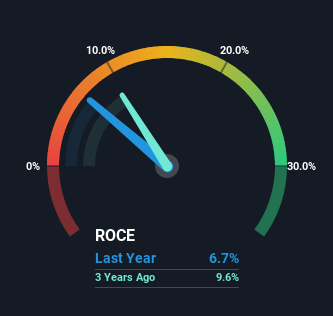- India
- /
- Consumer Durables
- /
- NSEI:WHIRLPOOL
Whirlpool of India (NSE:WHIRLPOOL) Is Reinvesting At Lower Rates Of Return

What trends should we look for it we want to identify stocks that can multiply in value over the long term? Ideally, a business will show two trends; firstly a growing return on capital employed (ROCE) and secondly, an increasing amount of capital employed. Ultimately, this demonstrates that it's a business that is reinvesting profits at increasing rates of return. In light of that, when we looked at Whirlpool of India (NSE:WHIRLPOOL) and its ROCE trend, we weren't exactly thrilled.
Understanding Return On Capital Employed (ROCE)
For those that aren't sure what ROCE is, it measures the amount of pre-tax profits a company can generate from the capital employed in its business. The formula for this calculation on Whirlpool of India is:
Return on Capital Employed = Earnings Before Interest and Tax (EBIT) ÷ (Total Assets - Current Liabilities)
0.067 = ₹2.9b ÷ (₹61b - ₹18b) (Based on the trailing twelve months to September 2024).
So, Whirlpool of India has an ROCE of 6.7%. In absolute terms, that's a low return and it also under-performs the Consumer Durables industry average of 11%.
See our latest analysis for Whirlpool of India

Above you can see how the current ROCE for Whirlpool of India compares to its prior returns on capital, but there's only so much you can tell from the past. If you'd like, you can check out the forecasts from the analysts covering Whirlpool of India for free.
So How Is Whirlpool of India's ROCE Trending?
In terms of Whirlpool of India's historical ROCE movements, the trend isn't fantastic. To be more specific, ROCE has fallen from 23% over the last five years. However, given capital employed and revenue have both increased it appears that the business is currently pursuing growth, at the consequence of short term returns. And if the increased capital generates additional returns, the business, and thus shareholders, will benefit in the long run.
The Key Takeaway
In summary, despite lower returns in the short term, we're encouraged to see that Whirlpool of India is reinvesting for growth and has higher sales as a result. However, despite the promising trends, the stock has fallen 24% over the last five years, so there might be an opportunity here for astute investors. As a result, we'd recommend researching this stock further to uncover what other fundamentals of the business can show us.
While Whirlpool of India doesn't shine too bright in this respect, it's still worth seeing if the company is trading at attractive prices. You can find that out with our FREE intrinsic value estimation for WHIRLPOOL on our platform.
If you want to search for solid companies with great earnings, check out this free list of companies with good balance sheets and impressive returns on equity.
Valuation is complex, but we're here to simplify it.
Discover if Whirlpool of India might be undervalued or overvalued with our detailed analysis, featuring fair value estimates, potential risks, dividends, insider trades, and its financial condition.
Access Free AnalysisHave feedback on this article? Concerned about the content? Get in touch with us directly. Alternatively, email editorial-team (at) simplywallst.com.
This article by Simply Wall St is general in nature. We provide commentary based on historical data and analyst forecasts only using an unbiased methodology and our articles are not intended to be financial advice. It does not constitute a recommendation to buy or sell any stock, and does not take account of your objectives, or your financial situation. We aim to bring you long-term focused analysis driven by fundamental data. Note that our analysis may not factor in the latest price-sensitive company announcements or qualitative material. Simply Wall St has no position in any stocks mentioned.
About NSEI:WHIRLPOOL
Whirlpool of India
Manufactures and markets home appliances in India and internationally.
Flawless balance sheet with proven track record.
Market Insights
Community Narratives





